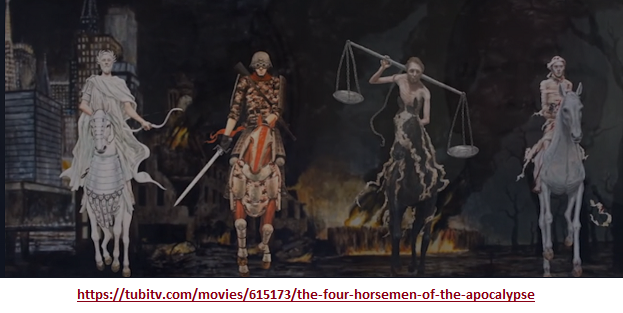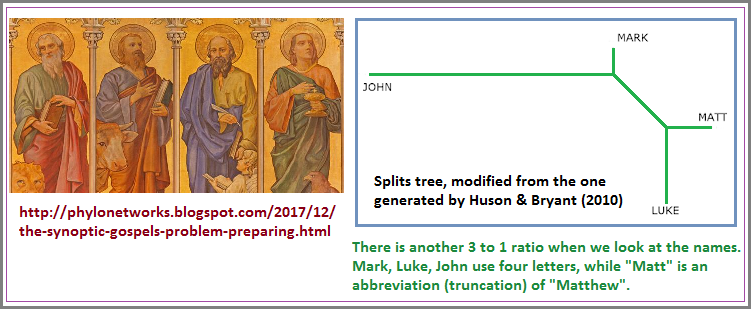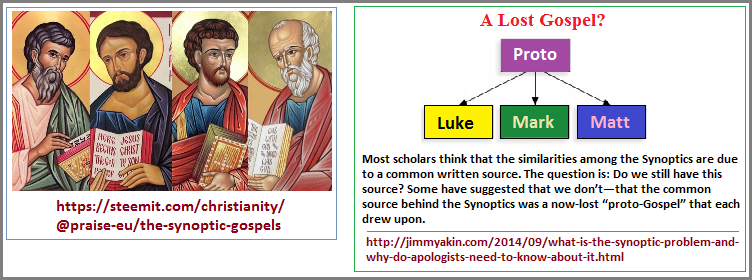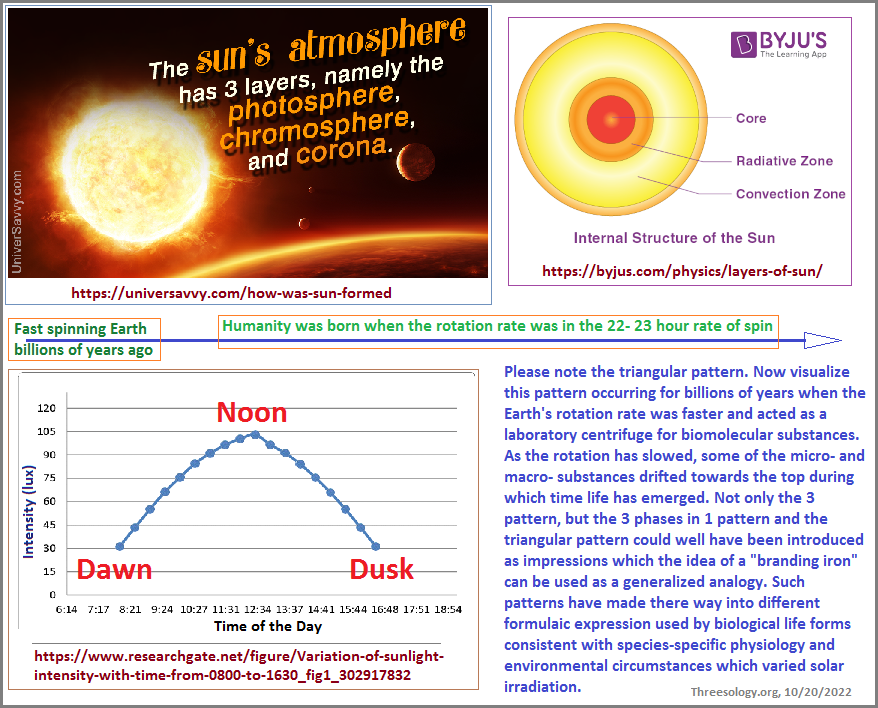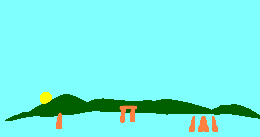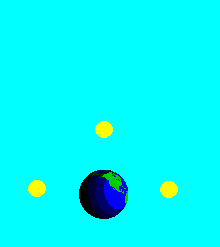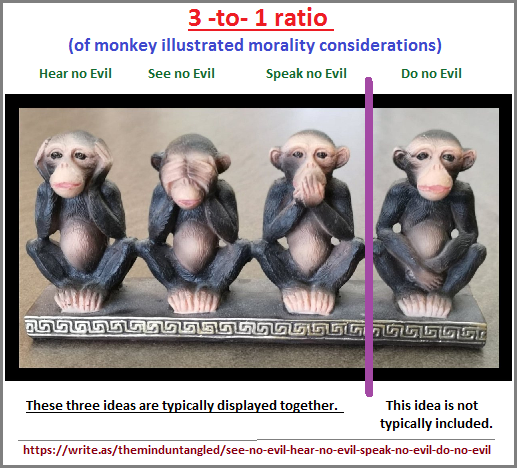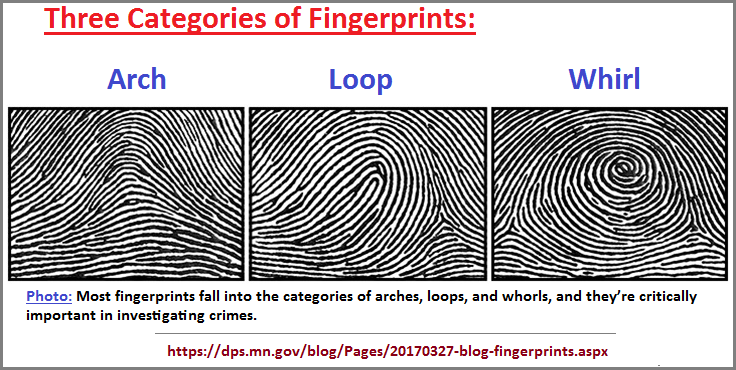page 26
Progressive Thinkers as of 5/8/2020
|
| ||||||||||||||||||||||||||||||||||||||||||||||||||||||||||||||||||||||||||||||||||||||||||||||||||||||||||||||||||||||||||||||||||||||||||||||||||||||
The Trifunctional Hypothesis is a specifically labeled "pattern -of- three" which represents an example of a recurring cognitive pattern. From the Wikipedia we find it described as:
The trifunctional hypothesis of prehistoric Proto-Indo-European society postulates a tripartite ideology ("idéologie tripartite") reflected in the existence of three classes or castes—priests, warriors, and commoners (farmers or tradesmen)—corresponding to the three functions of the sacral, the martial and the economic, respectively. The trifunctional thesis is primarily associated with the French mythographer Georges Dumézil, who proposed it in 1929 in the book Flamen-Brahman, and later in Mitra-Varuna
His idea was not explicitly labeled a "cognitive theme", and instead was treated as a specificity primarily belonging to an Indo-European tradition. However, if and when Dumézil encountered an Indo-European related society with four (or even more) divisions, it proved to be somewhat problematic, because Dumézil wanted to restrict his view to three compartmentalizations whose formula could not easily reconcile the present of another division such as the four-caste system In Indian, though we also find the group considered to be "outcasts" and therefore exempt from being considered from the so-called "true" or real society.
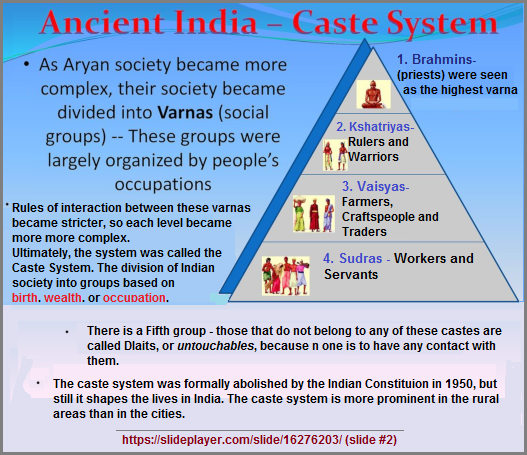
Simply put, the strictness of Dumezil's Trifunctional hypothesis attached to Indo-European societies was not flexible enough to include the presence of what might otherwise be considered the "odd man out". In other words, the presence of a 3 to 1 ratio, which is identified in value system of notation seen in basic arithmetic, were groups-of-three numbers such as ones-tens-hundreds are separated by a comma before the next 1, 2, or 3 numbers are included. Dumezil's idea can be viewed as accentuating a "Heavy" signature of "three" (as opposed to a medium or light signature), but unable to count higher where the another value could be included, such as in the case of a more-than-three caste system found in India. The size of the Indian population quite possibly created the conditions for needing a "higher count" in social divisioning, just like we see taking place as the U.S. population with it multiplicity of economic stratifications has influenced the notion of sub- and super- compartmentalizations added to the traditional three divisions of Lower, Middle, Upper classes, just as we see having occurred with the traditional small- medium- large sizes of clothing, as well as the flavor extensions to the tradition of Vanilla- Chocolate- Strawberry ice cream.
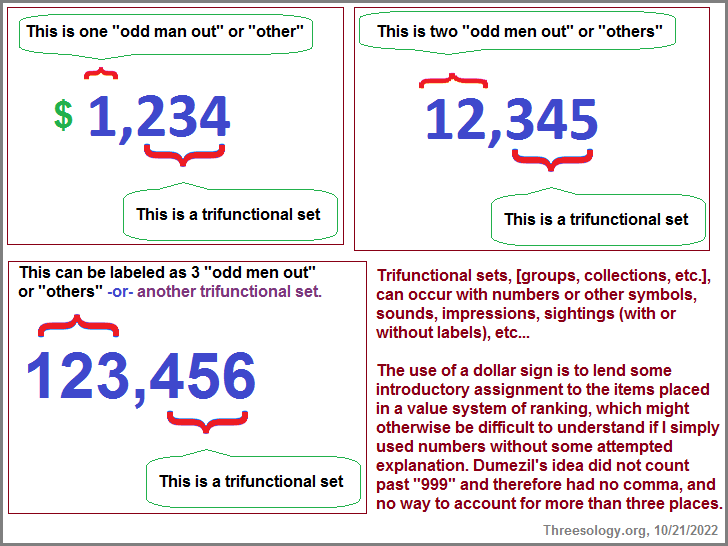
Here is a comment about Dumezil's trifunctional hypothesis which directs the reader's attention to what the writer believes to be a necessary inclusion for considering more-than-three divisions:
There are many reasons why Dumezil's work is controversial. Some of them are good, or at least reasonable, and relate to real issues on which he may have been wrong. For instance, I have argued elsewhere that his notion of a 'trifunctional' Indo-European ideology was incomplete: in addition to his three main categories or clusters of ideas (pertaining respectively to the sacred, to force and to abundance), we need to recognize a fourth, pertaining to 'otherness' and covering both transcendence/totality (which is valued) and exclusion/nothingness (which is devalued). Such an addition opens the way to certain other revisions (AlIen 1991; forthcoming a). But the present discussion concentrates on the 'bad" reasons why Dumézil is too little appreciated.} Debating Dumézil: (Recent Studies in Comparative Mythology) by N.J. Allen
Clearly the use of the term "otherness" can alternatively be described as the "odd man out". However, one should not think this is limited to a single item since if we view it in terms of a written expose' of numerical indexing, we see that a grouping of ones-tens-hundreds can be separate by a comma before a singular 'thousands' place value is characterized and that there is also the place for a second "odd many out" (so to speak), and that even a third place value could be equally labeled as such or take on a collectively separate identity unto its own right.
Some people think that a standard model of thinking can be described by a dichotomy referenced as "Black and White" thinking. Or another dichotomy such as Positive and Negative thinking. Alternative dichotomies abound such as input/output, higher/lower, rich/poor, strong/weak, smart/dumb, happy/sad, pretty/ugly, etc... The point being, such people overlook at the underlying two-pattern of such expressions and nor do they relate such an activity to early human counting efforts where before there were numbers, the concept of one, of a single item may well have been a monumental step in the consciousness of humanity. Where before there was no sense of number, no sense of quantity, some individual or group of ancient human-like creatures developed the notion of one, even if it was expressed with a grunt and no symbol scribbled on the ground, rock, stick, bone, shell or what have you. Next came the development of a "2" concept to replace notions which may have amounted to some concept of "everything else". Whereas the may have counted one and one and one, etc..., there was not concept which organized their thoughts of distinguishing a higher means of compartmentalizing a set. The concept of "2", described with word (some type of vocalization) or symbol (number, scratch, etc...), was yet another revelation and indication that the human brain was changing. Yet, once again, for any quantity above the "2" which may have been established by a simple pairing/contrast method, may not initially have had a concept to distinguish the existence of such a realization, even if the realization was an intimation, hint, tip-of-the-tongue impression, Shadowy character, peripheral vision encounter, visionary, madness, insanity, hyper-vigilance, imagination, imagery, prophecy, old soul intuition, logic, deductive reasoning, etc...
We can imagine there were cognitive limits, as is suggested by those who have looked into the historical development of counting and mathematics. The problem with this is that we think our versions of past ideas, are not limited... that they are not extensions of cognitive limitations experienced by earlier humans who were not particularly bothered by such limitations and constructed a social order within the accepted boundaries of such limitations, just as of today do with our accepted boundaries, no matter how such boundaries are concealed by language and manipulated visual constructs more useful for purposes of entertainment than providing a stepping stone to uncharted cognitive territories of consideration. Many of the so-called "cutting edge" positions and ideas are just elaborations of cognitive limits concealed and over-valued by a desire to explore and find a new path of thinking. But not everyone is fooled. Such is the case with ideas found in all subjects. All of them have their way of describing cognitive limits by way of advertising them in such a way as to propose they are viable stepping stones instead of dead ends. For example, the idea of Four Horsemen of the Apocalypse (FHotA) is like a refrain heard back in the 1800s when gold was found out in the Western United States (and elsewhere), and is sometimes called (with a 2-patterned phrase) Gold Rush, gold fever, or even (a 3-patterned phrase) "Gold Rush Fever".
Somewhere along the line in human consciousness, and I am not trying to suggest all groups of human-like creatures had brains which developed in the same manner or sequential time periods of cognitive maturation since "mutations" of thinking can take place that we of today might call inspiration, creativity, genius, luck, insight, or whatever. From personal experience I know that ideas or inspirations can just "pop" into consciousness. And while some may interpret such events with a value that overwhelms them because they are few and far between, others may not react as if they have been struck with lightning to the extend everyone else should also react in a similar manner and conclude that what was experienced is to be held up as a view to be paid homage to.
In an attempt to get the idea of a standard, general, common Cognitive model... a sort of blue-print or scaffolding, though other analogies can be used, it is necessary to provide some representative example that may be well known, but only understood in a given sense of symbolism and needs to be alternatively interpreted. Let us take for example the concept of the Four Horsemen of the Apocalypse and succinctly described in the following Britannica article. It is of need to note I am not advocating the idea as it is stated and am using the description merely to point out the presence of a recurring mental (cognitive) pattern found in different guises in different subjects:
Four horsemen of the Apocalypse, in Christianity, the four horsemen who, according to the book of Revelation (6:1–8), appear with the opening of the first four of the seven seals that bring forth the cataclysm of the apocalypse.
- The first horseman, a conqueror with a bow and crown, rides a white horse, which scholars sometimes interpret to symbolize Christ or the Anti-Christ.
- The second horseman is given a great sword and rides a red horse, symbolizing war and bloodshed.
- The third carries a balance scale, rides a black horse, and symbolizes famine.
- The fourth horseman rides a pale horse and is identified as Death.
Far too many take this description literally. The first three can be said to describe degrees of impermanence, while the so-called fourth one describes a permanent condition, unless of course you opt for the idea of a life after death, or a continuing cycle of death and rebirth. So many people are fed up with the hypocrisies of government, religion and businesses which often perpetrate various impoverishments, they seek some sort of Saviour in the design of a cataclysmic devastation for all of humanity, be it by some religions notion, or natural event that they may well link to religion by way of a god notion.
From the same biblical text (the New Testament) one can also encounter another so-called "4" reference is found in the gospels of Matthew, Mark, Luke and John. And while writing them in a sentence form of listing reveals a 3 -to- 1 ratio by having three of them separated by the word "and" from one other, this three -to- one expression is taken for granted. Another 3 -to- 1 ratio crops up when we look at the Names. While Mark, Luke, John all have four letters, the name "Matthew" undergoes a truncation... an abbreviation to form the four-letter "Matt". The set of three described as Mark- Luke- Matt are sometimes referred to as the Synoptic Gospels (the word "gospels" supposedly referring to "good news"), while John is sometimes called the Idiosyncratic gospel, because it differs in its account of Jesus while the other three are quite similar. However, the "3 -to- 1" ratio pattern is not recognized by the so-called experts because they are unable to take their head out of the sand for a moment and see it as a cognitive pattern (instead of defining it as a literary one, or a religious one) which is not confined to this particular subject, but can be found elsewhere. Like the Christian Trinity being described by some as "3 persons in 1 god" (like the 3 phases in 1 Sun (dawn- noon- dusk) from which the Trinity idea originated in "Pagan" history), they too overlook the usage of a 3 -to- 1 ratio profile being used in multiple ways in multiple different subjects. Far too many are so obsessed with religion, they lack the objectivity to pay witness to the presence of a recurring cognitive pattern that I believe is connected to environmental influences representing a functional "conservation of number" usage as a survival mechanism.
Let me itemize the three variations of the 3 -to- 1 ratio previously mentioned:
- Matthew, Mark, Luke AND John. (The word "and" is like the "comma" used in mathematical notation which separates the ones- tens- hundreds from the thousands, etc...)
- Matt, Mark, Luke (synoptic)... John (Idiosyncratic) (The word "synoptic" is being used as a point of separation just like we use the conjunction "and" in grammar (of which there are three basic types of Conjunction: (coordinating, subordinating, correlative) or the set-of-three "comma" rule in arithmetic such a $ 1,234,456,890: 1 billion, 234 million, 456 thousand, 890 dollars.)
- Mark, Luke, John (4-lettered names)... Matt (an abbreviation to deliberately create a 4-letter name).
Taken by itself, the 3- to- 1 ratio being profiled is easily overlooked and does not even enter the territory of consciousness of most people. But when we define it in terms of a general reference to cognitive... mental behavior viewed as a blue-print etching that some may interpret to be scratch pad doodling or drawing board musefulness; then if I were to say that in the U.S. we predominantly use 3 phase (for commercial applications) and 1 phase electricity (for most domestic household applications) as another example of the same pattern... perhaps this might intrigue the reader to view some other examples found here: Three to One ratios. Indeed, for those unafraid of new ideas, let us explore the idea of a 3 -to- 1 ratio by looking at such examples as I have previously listed.
However, many religious people might well want to discount such a correlation as having any value for consideration or discussion, since their first knee-jerk reaction would be to interpret such an pattern- idea existing in the Gospels thus defines it in lesser terms to which their enormous ego feeds on the presumption that their religious orientation is first and foremost amongst any and all ideas. How dare someone such as myself claim that the gospels or even all religious texts can be viewed in terms which is akin to scrapping the idea that the Earth... and hence some earlier ideological religious stance, is not at the center of all things. And yet that center may be the recurring underlying patterns overlooked by being unaware of them or overlooked due to mis-referencing them.
Triangular pattern of Sun (and Moon) as an impression.
Some examples: spear/arrow heads, pyramids, tepees, boomerangs, V-shaped engines, termite mounds, ant-lion burrows, human tail bone, bowling pin and billiard ball alignments, v-flight formations, (also truncated or half-measure expressions), etc...
3 historical solar path geometries:
1) Linear (across the sky)
2) Circular (dome or sphere)
3) Triangular (Earth as a triaxial ellipsoid)
Eventuality of 3 -in- 1 fusion of solar phases and influenced ideological constructs due to expansion of Sun as it deteriorates over time and absorbs the innermost 3 planets.
Examples of ideological constructs:
E Pluribus Unum (out of many, one), Three persons in one god, 3 engines used in 1 space shuttle, 3 to 1 ratio of piston rings, 3 coins (nickels, dimes, quarters) accepted by many vending machines, 3 fingers to hold a pen or pencil, 3 upper right corner computer screen manipulations, etc...
Another 3 -to- 1 ratio can be found in the concept of 4th monkey (do not evil), whose inclusion as a further morality stricture with the customary depiction of Three Wise Monkeys:
Indeed, one might want to think of the 3 -to- 1 ratio as profiling 3 items to be itemized as a set, and therefore might alternatively be described as a "signature", which is a term that is sometimes used to highlight a particular distinction, like the signature of a person provides them with distinction and that distinction may well have accompanying attributes that may at times be categorized as Heavy, Medium and/or Light. In Forensic Handwriting and Signature Analysis, we find three Key stages: 1) Analysis, 2) Comparison, 3) Evaluation. While this itself may raise any eyebrows, let us also include a reference to Finger Prints by saying they're all variations on three broad categories:
- The arch, which looks a bit like a cross-section of a hill.
- The loop, which is teardrop-shaped.
- The whorl, which is reminiscent of a whirlpool.
If we include cases of people who do not have the typical fingerprint patterns (double loop whorl and accidental) or those who have Adermatoglyphia (without skin ridges), we have created another category bringing the value to be a 3 -to- 1 ratio.
But since I am on the topic of human identification, let us include the idea that humans have three different types of hair: Lanugo, Vellus hair, Terminal hair, along with 1st, 2nd, and 3rd Molars, as well as wear glasses which may have mono-focal, bifocal or trifocal lenses. To this let us add that most people are unique combinations of the three body types:Ectomorph, Mesomorph, and Endomorph, called the 3 Somatypes.
If there are basic patterns of mental activity for humans that exist, a standard word such as archetype may inaccurately define it, since the word become adopted by the vernacular and ideas corresponding to a particular subject. Such a word becomes inaccurate because it does not lead all humans to the same reference, but offshoots of some imagined "core" image no one can agree on, even if they use a word such as proto-type, original or primitive first. Then again, maybe there was no singular representative model and the use of multiple representations is most accurate. In any case, even the use of numbers as symbolic references to some supposed archetype can be alternatively interpreted just as are the different penmanships of people. However, despite our assumed vagueness, we come to agree to call something by the same word or describe it by the same symbol, though the symbol may be expressed with an accent, in a different language as well as by way of a different medium. For example, in describing the number 1 in math is different than if we use music, dance, a sporting event, or other non-number and non-word illustration. Some illustrations of very simply ideas can be quite complicated or involved, particularly if the same medium is used by different people who apply their elaborations. Others simply dislike another finding a simple theme in something which they worked hard on, as if in finding a simply pattern means their views and efforts are likewise to be interpreted as simple and therefore not important or to be valued less.
While the author was no doubt focused on using the "4" and "7" numbers, just like some riders intentionally used "3", I want to suggest that we interpret the portrayal of the four horsemen as a 3 -to- 1 cognitive ratio. It is similar to a Native American drum beat where three beats are emphasized by being set apart from a single beat. There is a group -of- three beats and then 1 beat. Yet numbers need not always be used to convey the sense of an idea, such as in the case of the expression E Pluribus Unum... which is latin for Out of Many, One. The word "many" is an ancient number or quantity associated word aligned with a primitive past in which there were limits in the counting schemes of primitive peoples.
It is not difficult to imagine the development of counting amongst humans in a recessed past of cognitive development in which the individual values of 1 and 2 each became a cognitive limit and that beyond the "2" as it was previously for the "1", was met with some notion of quantity which would encompass some measure of comprehending multiplicity just like we of today may use words such as polynomial, infinity, a whole bunch, 'millions/billions/trillions of them', eternity, forever, etc... The word "many" in the counting scheme of "one- two- many" is a three-patterned expression which can be used as a general description of early counting efforts, just like the use of a comma comes to mark off a set of three in our present day place value system. Even if you don't believe that early humans had a counting scheme equivalent to the "one-two-many" phrase where the word "many" may have had a substitute such as plenty, heap, pile, much, more, a lot, bunch, etc., the phrase can nonetheless be used to represent the idea of an early counting system with limitations, just as we of today have no problem accepting the word "infinity" for the concept of some totality without end.
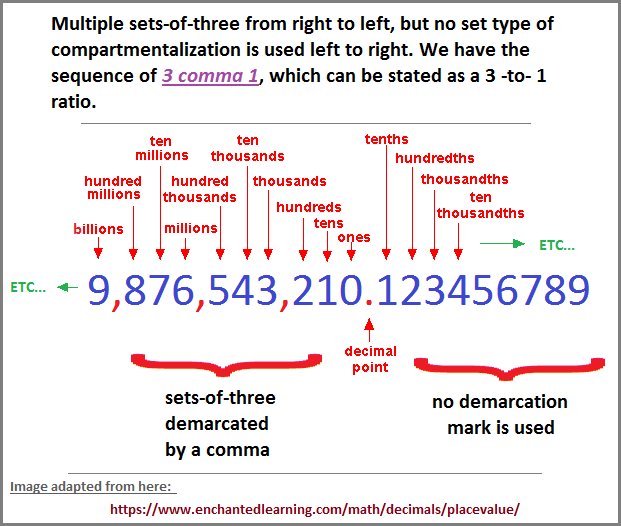
Mathematics is one of those tools which does not always lend itself towards being the necessary formula by which a multi-faceted assortment of attachments are readily available to provide assistant with any and all tasks, as suggested by the design of a Swiss Army knife being used as an analogy. One of these tasks is in the analysis of itself as a cognitive pattern; since mathematics is a pattern of thinking and a way of observing reality that might otherwise be subjected to illustrations involving music, arts and crafts, and words (as a singular model) in its various genres of exploration (poetry, essay, novel, speech, brochure, etc...). It is difficult for someone who is neck, or even ankle deep in mathematics to see it as a 2-patterned mental construct similar to the design of the old Yin/Yang collection of dual-patterned constructs. The basic two-patterned formulation of thought orientation is not customarily taught with an emphasis for recognizing Mathematics as a repository of dualities, much in the manner the Yin/Yang idea presents itself as. Thus, as I will say again multiple times, I presently view Mathematics as a Westernized portrayal of the old Easternized 2-patterned mindset. The same 2-patterned mental formula exhibited by Eastern peoples of long ago became prominent in Western cultures in the form of Mathematics. And both of them, in their own way, have struggled to move beyond the two-patterned orientation to develop a three-patterned dominant perspective, but that neither of them has succeeded.
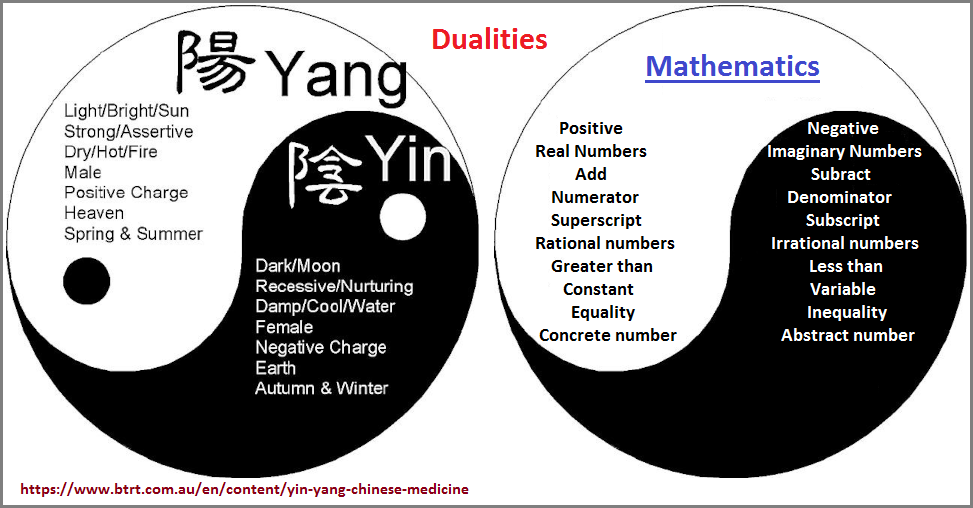
Whereas some will claim that humanity, due to the self-same physiology will necessarily exhibit similarities of thought patterns; details of which ideas are similar do not always come to the fore of consideration particularly if the form in which a basic idea is being illustrated, is presented with some notion of regality. For example, defining Mathematics as the Queen of all sciences also presumes its partitioners are of Nobel birth themselves... and are therefore not to be subjected to any critical analysis which might suggest having had less than a blue-blood lineage of which to boast and brag about. Similarly, some people do not see humans as animals and prefer to define themselves as being made in the image of some superior being called (a) god. Labels, titles, headings, etc., all serve to pronounce something or someone that is to be set apart from the common, the customary, and the otherwise banalities of everyday existence. Using symbols and an adopted vernacular of specificity can serve the same purpose of egotism.
In contrast to what several script writers have deemed to be some measure of common sense when speaking of Mathematics as a Universal language which all sentient beings in the Universe will understand; such script writers are not particularly insightful philosophers or analysts of the human condition in order to realize that human mathematics is a mental construct developed by a particular species of life form under particular conditions. Whereas when humans of the present have looked upon the exhibited written expressions of past civilizations and interpreted such writings in the context of human activities; such will not necessarily be the case for an extra-terrestrial's mindset. Human ego very often gets in the way for an adequate interpretation and explanation of human behavior. Humans are pretty stupid creatures that no made-up title or social position can disguise. Thomas Hobbes's in his Leviathan is referenced as saying it differently:
Hobbes also considers humans to be naturally vainglorious and so seek to dominate others and demand their respect. The natural condition of mankind, according to Hobbes, is a state of war in which life is "solitary, poor, nasty, brutish, and short" because individuals are in a "war of all against all". (Thomas Hobbes: Methodology)
For all we know, Hobbes may have projecting an image of himself into his description since not everyone fits each and everyone of these descriptives. While some people are solitary, or poor, or nasty, or brutish or short, not everyone is. Particularly not as a singular character. If we were to place the mindset of Hobbes onto a standup comedian of today, he might well get applauds from some and jeers from others. For all we know, personal health and/or living conditions created and sustained his pessimism that he came to confront by suggesting some model of parliamentary government could greatly improve the lot of humanity. However, all ideas have an underlying pattern related to cognitive activity which can be listed and counted to see if there is any fundamental change in the direction of progress that we may reduce to a simple 1-2-3, A-B-C sequencing. However, in using such easily understood sequences to represent some imagined eventual progressively acquired step, overlooks the fact that despite an infinity of numbers, we humans rely most on small number references which are repeated in labels meant to express an enlargement. For example, we repeat ourselves when we get to millions, billions, trillions, since they are 1, 2, 3 designations seen in the first two letters, even if the "mi" is not readily seen as referencing "one". Whereas the "bi" in billion and the "tri" in trillion are more easily seen as a repetition of 2 and 3, one can easily infer that the 1-2-3 sequence is being repeated.
But let me get back to comparing the underlying pattern to be found in Mathematics with that seen in the Yin/Yang philosophy. While you may be familiar with the dualities portrayed by those interested in the Yin/Yang idea, it is not customary to find multiple people displaying the dualities to be found in Mathematics. Both of them exhibit a similar basic brain activity to be found in early human efforts to develop some sense of number... by way of counting, be it an accounting sheet used for some commercial purpose or otherwise. A few examples should suffice:
Number patterns, particularly those which repeat and are identified in ideas, expressions, or activities... suggest cognitive patterns otherwise known as mental patterns; even though some may occur to a given person due to mimicry, a reflex, or an instinct. Since this website focuses primarily on patterns-of-three, this does not mean to say I ignore the presence of other enumerated patterns or those patterns not easily associated with some number. In other words, yes... I am aware of patterns in ones, twos, fours, fives, sixes, sevens, eights, nines, etc...And yes, there are patterns referred to as indistinct impression, inter-dimensional considerations, time-travel overlappings, subtle energies, embedded memories, transient allusions, etc... Some patterns may even only be possible due to a specific culture, gender, socio-economic class, preoccupation, diet, age, genetic history, etc... Yet, if something is not quantifiable by either number or word, then it must be counted as one of those which are not presently countable. The "what-ifs", "maybes", and "possibilities" can only be counted (at present) as a fraction of typical considerations, even though one or more may play a larger part sometime in the future when human physiology has changed more so in a particular direction of an evolutionary endowment.
Patterns subjected to enumeration can be listed side by side. No, I have not listed all instances of any number pattern. However, though you may argue for the presence, the persistence, the importance of some other number (or non-number) pattern, I urge you to recognize the absence of the pattern you are attempting to use as an argumentative tool, as if it were a wrench that can be mischievously used to inflict irreparable damage to the cycles of research being undertaken with respect to the "Threes" phenomena. Clearly one might argue that the pattern of "existence" is everywhere, but only because we do not know how to recognize non-existence in all terms, and not just human acknowledgements. However, the concept of existence is not a recurring pattern of conceptualization as an object of consciously attending to it as a consideration.
Just because I list patterns-of-three occurring in religion, mythology, ufology, crop-circles, witchcraft, the supernatural, etc., doesn't mean I am advocating any one of them as a primary interest that I or someone else should believe in. The fact that such topics are of interest to multiple humans and that such topics have ideas which can be enumerated, reveals human mental patterning taking place in different subjects. If you want to believe in monsters, demons, changelings, werewolves, zombies, vampires and the like, by all means... go right ahead. My interest in such topics is to identify recurring patterns of enumeration, even if skilled and/or knowledgeable people of such ideas are not even aware of their usage of particular patterns which can be enumerated. You can not always rely on experts to give you an expert opinion about the patterns being used in their work, whether or not they engage in enumeration themselves. And if they don't, I must ask why not? When the use of enumeration is so widespread, its absence... or at least the absence of someone acknowledging the presence of absence of enumeration should be noted. How you define it is up to you... in a positive or negative or neutral manner.
Note: Someone interested in Bigfoot sightings and also interested in establishing a count, might want to search at North American Wood Ape Conservancy to identify how many people are involved with a given sighting for all records. Is the case that more single (people alone) have had a sighting, or two people? or a group? The same idea can be applied to all collections of "sightings", be it Bigfoot or otherwise. I bring this up because there is a countable reference with respect to the Nobel Prize (A Nobel Prize can be shared by up to three individuals.). If one takes a look at All Nobel Prizes, we see that at its initial inception, there were 1 or 2 people named, but in later years the value of "3" was set at the maximum. No matter how you wish to provide the rationale for doing so, the fact remains that the count was stopped at 3. Typically, if there are more than three individuals, a single institution can be referenced unless the three feel they are the primary researchers and everyone else plays the part of Frankenstein's Igor. However, from this Quora search: Frankenstein's Igor, we find the following reference:
The character of Igor wasn't originally in the (Mary Shelly's) book "Frankenstein", and in the 1931 movie, the character was named Fritz. Igor’s first appearance in the Frankenstein films is Bella Lugosi’s brilliant performance as Igor in "Son of Frankenstein" the third, and IMO best, of the Universal Frankenstein pictures. Igor, in this iteration, is a man who has survived hanging, his neck was broken but he lived twisted and embittered. Igor has discovered and befriended the monster and uses the creature as a personal weapon for vengeance.
(Note: the three letters "IMO" means In My Opinion.)
Being on the Third planet from a Sun is a number pattern which may not have any meaning to most people other than in the context of its relationship to the other planets, but when we start to find the same number (with or without an identified "set-of-three"), we may necessarily ask if their is reason and purpose for such a repetition. If you are religiously inclined you might say "3" is (a) god's number. If you are some model of Naturalist you may claim it to be Nature's number, without referencing the idea of a god... since you prefer to think of the concept of a singular god as an example of the human mind using the value "1", which is routinely found in egocentric references... but not always. Words and phrases which can be substituted for the "1" can be seen as "Universe" or even "world", such as in "champions of the world", or the "greatest" army, or "Great" Britain, etc... The use of a "1" idea is quite common as noted by the word Narcissism, or self-love; as some argue is what is being expressed in homosexuality and lesbianism... that they love themselves vicariously in someone of the same gender. There are of course other interpretations as well... and additional analogies such as taking pictures of oneself that has (during the second decade of this century) been labeled a "selfie". It is an activity which reminds me of an animal that comes to see its own reflection and either interprets it as a friend, foe or facade.
Does Nature love the number 3 as suggested by Mark Mahin's list, or do we humans only think Nature does because such a pattern has some underlying form (that we humans label with a number value) which is necessary for survival due to an incrementally deteriorating environmental sequence?
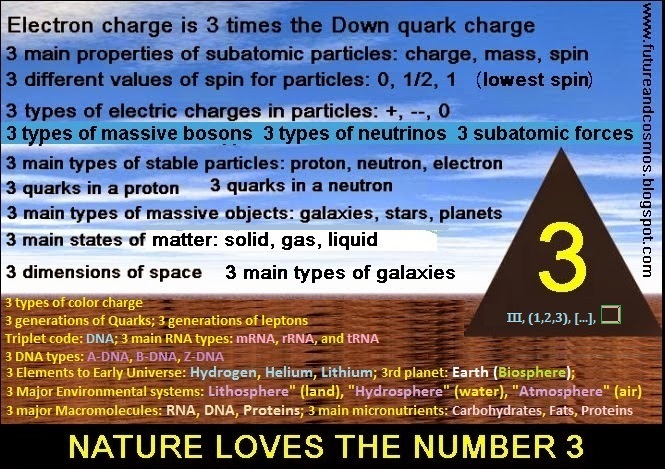
By the same token, does Dr. McNulty's List of threes in human Anatomy actually represent reality, or is it something humans made up just as they attached a recurring usage of "three" to religion, superstition, fairy tales, mythology, clothing sizes (small- medium- large), fan speeds (slow- medium- fast), teaching the alphabet (ABC's), time allocations (seconds- minutes- hours), etc., while at the same time overlooking a signature of three in multiple references some may designate as a "four" but I see as a 3-to-1 ratio... such as a leap year involving three regular years and then one as an "odd man out". The formula of "3" and "1" is another recurring pattern being overlooked by typical cognitive scientists whose research often entails specialized views of specialized data for a specialized application, typically involving a specialized (subject-specific) vocabulary and associated ideas which limits an otherwise needed expansiveness of consideration(s).
Let me momentarily digress from an enlarged introduction about a recurring cognitive pattern which so very many people take for granted and may typically come to reference it in a singular way, by supplying a forth-coming image about a topic in which the pattern is embedded in the content and makes the news from time to time involving the theft of Catalytic converters— whose 3 precious metals formula (Palladium, Platinum, Rhodium) can be numerically correlated to other topics that periodically find their way into media discussions periodically, and by consequence may be thought of as you listen to a radio program while driving a vehicle (or riding a bus/tram)... perhaps on your way to a University which offers three academic degrees (Bachelor's- Masters- PhD) and encountering several 3-colored (red - yellow - green) signal lights, which is a visual acuity made possible by having three cone cell types in our eyes, along with the three currently known types of photoreceptor cells in mammalian eyes: 1) rods, 2) cones, and 3) intrinsically photosensitive retinal ganglion cells..
Three types of cone cells in our eyes (with the following percentages, and is a tell-tale sign that such a system of ranking is to be found {with varying percentages} in all cognitive patterning):
- Red-sensing cones (60 percent)
- Green-sensing cones (30 percent)
- Blue-sensing cones (10 percent)
The idea of a "percentage ranking system" is not a common consideration for those in cognitive research. At least I have not found anyone speaking of such. They are as oblivious to the idea (just as I have been) as well as recurring uses of enumeration taking place in varying formulas. Whereas formulas are used to assert a point, they are not used in the sense I am making them a point of assertion about cognitive repetitions. For example, we find gun-powder constructed by using different percentages: 75% nitrate,15% charcoal, 10% sulfur. Also, Retail gasoline stations in the United States sell three main grades of gasoline based on the octane (percentage) level:
- Regular (the lowest octane fuel–generally 87)
- Midgrade (the middle range octane fuel–generally 89–90)
- Premium (the highest octane fuel–generally 91–94)
- Three percentages rule used in statistics: the 68–95–99.7 rule, also known as the empirical rule, is a shorthand used to remember the percentage of values that lie within an interval estimate in a normal distribution: 68%, 95%, and 99.7% of the values lie within one, two, and three standard deviations of the mean, respectively.
- The rule of 97 percent (where the 3% value is indexed)
However, other percentages are neither clearly defined nor even suggested, requiring one to look further such as at construction details that can be mapped out using some model of mathematical referencing. Take for example:
- Most vending machines simply compare physical characteristics of coins, such as 1) their diameter, 2) thickness and 3) the number of ridges on the edge.
Date of (series) Origination: Saturday, 14th March 2020... 6:11 AM
Date of Initial Posting (this page): 1st March 2022... 6:04 AM
Updated Posting:Saturday, 23rd October 2022... 9:58 AM, MST; Albuquerque, NM.
